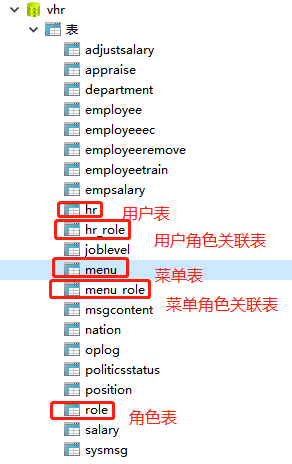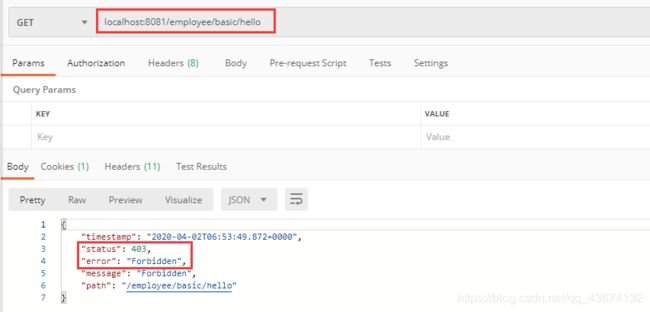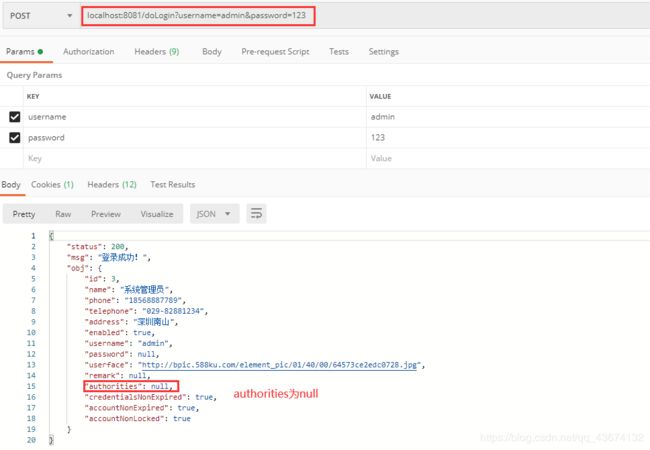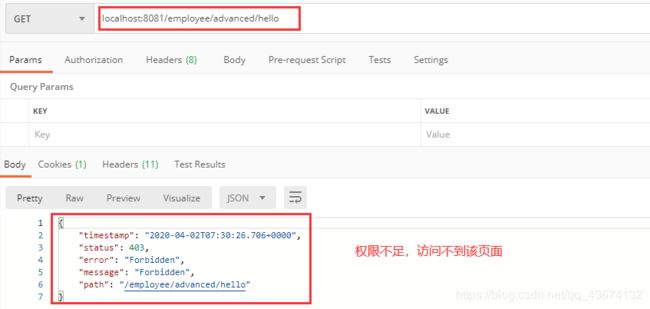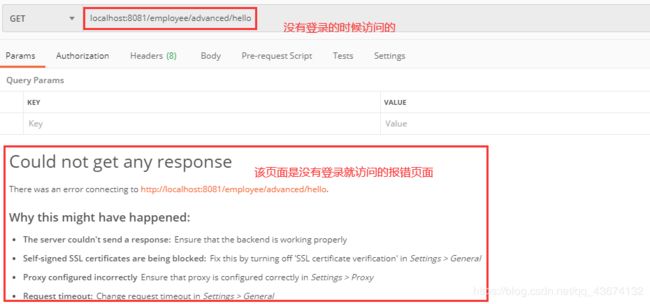用Spring Boot+Vue做微人事项目第九天
用Spring Boot+Vue做微人事项目第九天
前两天做了微人事登录的前端页面和后端接口,第三天则实现了前后端接口的对接,输入正确的用户名和密码之后,成功的跳转到home页。第四天做了Home页的Title制作和下拉菜单,下拉菜单有三个选项,个人中心、设置和注销登录,还做了注销登录,点击注销登录会出现提示:“此操作将注销登录,是否继续”,点是就重新跳转到登录页面,第五天做的是左边的导航菜单,第六天是做的服务端菜单接口的设计,第七天是Vuex的介绍、安装和配置、第九天是不写代码,谈一谈前后端分离开发,权限管理的一些思路,今天是后端接口权限设计
要利用Spring Security做动态权限控制,首先看一下数据库的权限控制的表
首先用户登录成功之后,会有用户id,根据用户id我可以查询出来他有哪些角色,根据他的角色我可以查询出来他可以操作哪些菜单,再到menu表中查看操作了哪些菜单
在进行接口设计的时候必须要和数据库中的menu表中的url属性是对应的
思路:
简单来说分为两步: 第一步,用户先从前端发起一个http请求,拿到http请求地址之后,我先去分析地址和数据库中的menu表中的哪一个url是相匹配的。就先看一下用户的请求地址跟这里边的哪一个是吻合的。
第一步的核心目的是根据用户的请求地址分析出来它所需要的角色,就是当前的请求需要哪些角色才能访问
第二步是去判断当前用户是否具备它需要的角色
注意:角色不分配给一级菜单,只分配给二级菜单,因为一级并没有一些实质性的接口
CustomFilterInvocationSecurityMetadataSource类
在config包中创建一个CustomFilterInvocationSecurityMetadataSource类,该类的作用是根据用户传来的请求地址,分析出请求需要的角色,该类需要实现FilterInvocationSecurityMetadataSource类并重写三个方法,第一个方法是最重要的。
第一个方法的Collection:当前请求需要的角色 Object:实际上是一个filterInvocation对象
从filterInvocation里面可以获取当前请求的地址,拿到地址后,我就要拿这个地址去数据库里面跟这里的每一个菜单项去匹配,看是符合哪一个模式,然后再去看这个模式需要哪些角色
String requestUrl = ((FilterInvocation) object).getRequestUrl();
@Component
public class CustomFilterInvocationSecurityMetadataSource implements FilterInvocationSecurityMetadataSource {
@Autowired
MenuService menuService;
AntPathMatcher antPathMatcher = new AntPathMatcher();
// collenction:当前请求需要的角色 Object:实际上是一个filterInvocation对象
@Override
public Collection getAttributes(Object object) throws IllegalArgumentException {
//从filterInvocation里面可以获取当前请求的地址,拿到地址后,我就要拿这个地址去数据库里面跟这里的每一个菜单项去匹配,看是符合哪一个模式,然后再去看这个模式需要哪些角色
String requestUrl = ((FilterInvocation) object).getRequestUrl();
return null;
}
@Override
public Collection getAllConfigAttributes() {
return null;
}
@Override
public boolean supports(Class aClass) {
return true;
}
}
修改model中的menu实体类
新加了private List
public class Menu implements Serializable {
private Integer id;
private String url;
private String path;
private String component;
private String name;
private String iconCls;
private Integer parentId;
private Boolean enabled;
private Meta meta;
private List修改service包中的MenuService类
在service包的MenuService类中添加一个根据角色获取所有菜单的方法,返回在menuMapper接口中查询到的数据
@Service
public class MenuService {
@Autowired
MenuMapper menuMapper;
/**
* 通过用户id获取菜单
* @return
*/
public List修改mapper中的MenuMapper接口
@Repository
public interface MenuMapper {
int deleteByPrimaryKey(Integer id);
int insert(Menu record);
int insertSelective(Menu record);
Menu selectByPrimaryKey(Integer id);
int updateByPrimaryKeySelective(Menu record);
int updateByPrimaryKey(Menu record);
List getMenusByHrId(Integer hrid);
List getAllMenusWithRole();
} 这个方法先不写,现在sql数据库里面把sql语句先写好,写对了,再复制过去
定义MenuMapper.xml
在CustomFilterInvocationSecurityMetadataSource配置类里面注入MenuService,然后通过menuService.getAllMenusWithRole()
获取到所有的菜单数据了,这个方法大多数情况下都不会变,可以在service层的该方法上加上@Cacheable缓存
@Component
public class CustomFilterInvocationSecurityMetadataSource implements FilterInvocationSecurityMetadataSource {
@Autowired
MenuService menuService;
AntPathMatcher antPathMatcher = new AntPathMatcher();
// collenction:当前请求需要的角色 Object:实际上是一个filterInvocation对象
@Override
public Collection getAttributes(Object object) throws IllegalArgumentException {
//从filterInvocation里面可以获取当前请求的地址,拿到地址后,我就要拿这个地址去数据库里面跟这里的每一个菜单项去匹配,看是符合哪一个模式,然后再去看这个模式需要哪些角色
String requestUrl = ((FilterInvocation) object).getRequestUrl();
// 这个方法每次请求都会调用
List menus = menuService.getAllMenusWithRole();
//比较request跟这menus里面的url是否一致 遍历menus 借助AntPathMatcher工具进行
for (Menu menu : menus) {
// String pattern:menus里面的规则
if (antPathMatcher.match(menu.getUrl(),requestUrl)){
List roles = menu.getRoles();
String[] str = new String[roles.size()];
for (int i = 0; i < roles.size(); i++) {
str[i] = roles.get(i).getName();
}
return SecurityConfig.createList(str);
}
}
// 没匹配上的统一登录之后就可以访问 "ROLE_LOGIN"只是一个标记
return SecurityConfig.createList("ROLE_LOGIN");
}
@Override
public Collection getAllConfigAttributes() {
return null;
}
@Override
public boolean supports(Class aClass) {
return true;
}
} 这样我们的第一步就完成了,第一步的核心目的:根据用户的请求地址分析出它所需要的角色
CustomUrlMyDecisionManager配置类
第二步:判断当前用户是否具备这些角色,我要在config配置包里面定义CustomUrlMyDecisionManager配置类,该类需要实现AccessDecisionManager并重写三个方法,第一个方法是最重要的
@Component
public class CustomUrlMyDecisionManager implements AccessDecisionManager {
/**
*
* @param authentication 当前登录的用户
* @param object 请求对象
* @param configAttributes 是CustomFilterInvocationSecurityMetadataSource类中的getAttributes方法的返回值
* @throws AccessDeniedException
* @throws InsufficientAuthenticationException
*/
//很好比对,用户的角色在authentication里面,需要的角色在configAttributes里面,再区比较他们俩集合里面有没有包含关系就行
@Override
public void decide(Authentication authentication, Object object, Collection configAttributes) throws AccessDeniedException, InsufficientAuthenticationException {
//遍历需要的角色
for (ConfigAttribute configAttribute : configAttributes) {
//它需要的角色
String needRole = configAttribute.getAttribute();
//如果它需要的角色是"ROLE_LOGIN"
if ("ROLE_LOGIN".equals(needRole)){
//如果当前用户是匿名用户的实例的话,就是没登录
if (authentication instanceof AnonymousAuthenticationToken){
//没登录就抛出异常
throw new AccessDeniedException("尚未登录,请登录!");
}else {
return;
}
}
//获取当前登录用户的角色
Collection authorities = authentication.getAuthorities();
//
for (GrantedAuthority authority : authorities) {
//如果这两个东西是相等的
if (authority.getAuthority().equals(needRole)){
return;
}
}
}
throw new AccessDeniedException("权限不足,请联系管理员!");
}
@Override
public boolean supports(ConfigAttribute configAttribute) {
return true;
}
@Override
public boolean supports(Class aClass) {
return true;
}
} CustomUrlMyDecisionManager配置类的作用是分析用户需要的角色你是否具备,如果具备,让请求继续往下走,如果不具备,则抛异常
两个关键类定义好了,接口来在SecurityConfig配置类里面把这两个定义好的配置类引入进来
@Configuration
public class SecurityConfig extends WebSecurityConfigurerAdapter {
@Autowired
HrService hrService;
@Autowired
CustomFilterInvocationSecurityMetadataSource customFilterInvocationSecurityMetadataSource;
@Autowired
CustomUrlMyDecisionManager customUrlMyDecisionManager;
@Bean
PasswordEncoder passwordEncoder(){
return new BCryptPasswordEncoder();
}
//要有一个configure方法吧hrService整进来
@Override
protected void configure(AuthenticationManagerBuilder auth) throws Exception {
auth.userDetailsService(hrService);
}
//配置登录成功或者登录失败向前端传送json数据
@Override
protected void configure(HttpSecurity http) throws Exception {
http.authorizeRequests()
//剩下的其他请求都是登录之后就能访问的
// .anyRequest().authenticated()
.withObjectPostProcessor(new ObjectPostProcessor() {
@Override
public O postProcess(O object) {
object.setAccessDecisionManager(customUrlMyDecisionManager);
object.setSecurityMetadataSource(customFilterInvocationSecurityMetadataSource);
return object;
}
})
.and()
//表单登录
.formLogin()
//修改默认登录的username
.usernameParameter("username")
//修改默认登录的password
.passwordParameter("password")
//处理表单登录的url路径
.loginProcessingUrl("/doLogin")
//默认看到的登录页面,如果是前后端分离的话,就不用配置登录页面
.loginPage("/login")
//登录成功的处理
.successHandler(new AuthenticationSuccessHandler() {
@Override
public void onAuthenticationSuccess(HttpServletRequest req, HttpServletResponse resp, Authentication authentication) throws IOException, ServletException {
//如果登录成功就返回一段json
resp.setContentType("application/json;charset=utf-8");
//这是往出写的
PrintWriter out = resp.getWriter();
//登录成功的hr对象
Hr hr = (Hr)authentication.getPrincipal();
hr.setPassword(null);
RespBean ok = RespBean.ok("登录成功!", hr);
//把hr写成字符串
String s = new ObjectMapper().writeValueAsString(ok);
//把字符串写出去
out.write(s);
out.flush();
out.close();
}
})
//登录失败的处理
.failureHandler(new AuthenticationFailureHandler() {
@Override
public void onAuthenticationFailure(HttpServletRequest req, HttpServletResponse resp, AuthenticationException exception) throws IOException, ServletException {
//如果登录成功就返回一段json
resp.setContentType("application/json;charset=utf-8");
//这是往出写的
PrintWriter out = resp.getWriter();
RespBean respBean = RespBean.error("登录失败!");
if(exception instanceof LockedException){
respBean.setMsg("账户被锁定,请联系管理员!");
}else if (exception instanceof CredentialsExpiredException){
respBean.setMsg("密码过期,请联系管理员!");
}else if (exception instanceof AccountExpiredException){
respBean.setMsg("账户过期,请联系管理员!");
}else if (exception instanceof DisabledException){
respBean.setMsg("账户被禁用,请联系管理员!");
}else if (exception instanceof BadCredentialsException){
respBean.setMsg("用户名或者密码输入错误,请重新输入!");
}
out.write(new ObjectMapper().writeValueAsString(respBean));
out.flush();
out.close();
}
})
//跟登录相关的接口就能直接访问
.permitAll()
.and()
.logout()
//注销成功后的回调
.logoutSuccessHandler(new LogoutSuccessHandler() {
@Override
public void onLogoutSuccess(HttpServletRequest req, HttpServletResponse resp, Authentication authentication) throws IOException, ServletException {
resp.setContentType("application/json;charset=utf-8");
PrintWriter out = resp.getWriter();
out.write(new ObjectMapper().writeValueAsString(RespBean.ok("注销成功!")));
out.flush();
out.close();
}
})
.permitAll()
.and()
//关闭csrf攻击
.csrf().disable();
}
} 接下来在HelloController控制类里面写两个方法测试一下
@Controller
public class HelloController {
@GetMapping("/hello")
public String hello(){
return "hello";
}
@GetMapping("/employee/basic/hello")
public String hello2(){
return "/emp/basic/hello";
}
@GetMapping("/employee/advanced/hello")
public String hello3(){
return "/emp/adv/hello";
}
}打开postman准备测试
这是中文名字属性本来是namezh小写的,现在改成大写的并修改该属性的getter和setter方法
public class Role implements Serializable {
private Integer id;
private String name;
/**
* 角色名称
*/
private String nameZh;
//省略getter和setter
}修改完之后,登录成功再访问新添加的两个接口都是403,forbidden,这是不对的
再返回看一下登录时的数据
这里为null是因为我们从头到尾都没有去处理用户角色
查看用户Hr类的返回用户的所有角色的方法的返回值为null,我要给用户搞角色,就可以在hr类里面放一个role集合属性
还要给roles赋值,因为默认登录成功之后,用户是没有角色的
public class Hr implements UserDetails {
/**
* hrID
*/
private Integer id;
/**
* 姓名
*/
private String name;
/**
* 手机号码
*/
private String phone;
/**
* 住宅电话
*/
private String telephone;
/**
* 联系地址
*/
private String address;
private Boolean enabled;
/**
* 用户名
*/
private String username;
/**
* 密码
*/
private String password;
private String userface;
private String remark;
private List roles;
/**
* 账户是否没有过期
* @return
*/
@Override
public boolean isAccountNonExpired() {
return true;
}
/**
* 账户是否被锁定
* @return
*/
@Override
public boolean isAccountNonLocked() {
return true;
}
/**
* 密码是否没有过期
* @return
*/
@Override
public boolean isCredentialsNonExpired() {
return true;
}
/**
* 是否可用
* @return
*/
@Override
public boolean isEnabled() {
return enabled;
}
public void setUsername(String username) {
this.username = username;
}
/**
*返回用户的所有角色
* @return
*/
@Override
public Collection getAuthorities() {
List authorities = new ArrayList<>(roles.size());
for (Role role : roles) {
authorities.add(new SimpleGrantedAuthority(role.getName()));
}
return authorities;
}
} 在HrService类里面用户登录成功之后,给用户设置角色
@Service
public class HrService implements UserDetailsService {
@Autowired
HrMapper hrMapper;
@Override
public UserDetails loadUserByUsername(String s) throws UsernameNotFoundException {
Hr hr = hrMapper.loadUserByUsername(s);
if (hr == null) {
throw new UsernameNotFoundException("用户名不对");
}
//登录成功之后,给用户设置角色
hr.setRoles(hrMapper.getHrRolesById(hr.getId()));
return hr;
}
}在HrMapper接口里边加上getHrRolesById的方法
@Repository
public interface HrMapper {
int deleteByPrimaryKey(Integer id);
int insert(Hr record);
int insertSelective(Hr record);
Hr selectByPrimaryKey(Integer id);
int updateByPrimaryKeySelective(Hr record);
int updateByPrimaryKey(Hr record);
/**
* 通过用户名查找用户
* @param username
* @return
*/
Hr loadUserByUsername(String username);
List getHrRolesById(Integer id);
} 在HrMapper.xml文件里面加上如下代码
现在再重启项目,登录成功之后访问localhost:8081/employee/basic/hello,显示如下:
访问localhost:8081/employee/advanced/hello,显示如下:
还有个小bug就是没有登录之前,就访问接口,会出来如下页面:
解决方法:
可以在SecurityConfig配置类里面加个方法即可,代码如下:
@Override
public void configure(WebSecurity web) throws Exception {
web.ignoring().antMatchers("/login");
}至此,后端接口权限设计已经完成了
